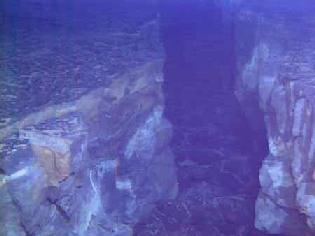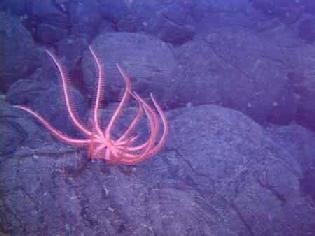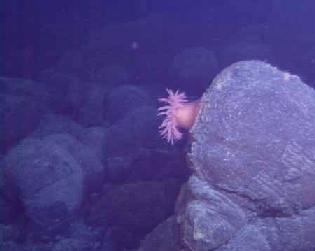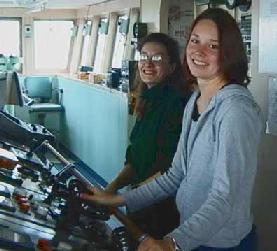WHAT'S NEW:
BACKGROUND:
Mission
Project Description
Cruise Plans:
Participants
Technology (ROV, ships, etc.)
Future Plans
Results:
1998 NeMO Cruise
Axial 1998 "Eruption"
Logbook
July 4, 1999
July 4, 1999
Contents:
- News from Thompson
- Participant Perspective
- Logbook from Teacher at Sea
- Question/Answer from shore to sea
Thompson Science Report
Science Report - Sunday, July 4
Ships Location: 45 55.9/129 58.8
 New lava flow at the bottom of the fissure, southern extent of 1998 eruption. (Dive 494) |
Listing of all Science News postings
Life at Sea: Participant Perspective
Marlene Le Bel and
Catherine Charpentier
University of Quebec
A labordage! Hi! My name is Marlene Le Bel and I'm one of the two French Canadian student researchers onboard the Thomas G. Thompson. Im a 23 years old woman who wants to travel and learn everything related to the ocean. I have a certificate in ecology and am in my second year as an undergraduate Biology student. I am currently working for Dr. Kim Juniper at University of Quebec at Montreal during the summer. Our first project is to map Cloud vent because it is so difficult to navigate underwater with the submersible and know exactly were we are even if we use high tech instruments. Mapping this site is also important because it is impossible to have an overview of the whole site when the water is cloudy with suspended particles due to the lack of light. Secondly, we will try to create another map (I hope so) of the vent Marker 33, a new site formed by lava flows of the 1998 eruption. A map of this area would be useful to the many scientists who wants to study here and follow its evolution year after year. To complete the mapping objective, we have to build mosaics with images that are digitized from video. To build mosaics and maps, well be using IP Lab Spectrum, Photoshop and Freehand software and a lot of patience. In order to get precise images, ROPOS pilots will have to position the camera specifically, so each image taken is kept at a constant angle and distance from the object. Stability of the platform (ROPOS) is a must for the best results. Finally, thanks to Dr. Juniper and NSERC undergraduate scholarship, this is my first experience on a research vessel I hope that it will not be my last one.
~ SEA you next time!~Marlene.
Hi ! Im Catherine Cat the kat (its better in English) Brittany, little Brittany, in France (the "Bretons" colonized the planet, of course !!). I'm the third French scientist on this boat. Its a little difficult for me because I understand what people talk about, but very few words exit from my lips I try. And most important, Im not seasick, very surprising for a first cruise, but very important for my work!!!
I have a French Masters in Molecular Biology, animal and plant Physiology, and Microbiology. Im a molecular biologist but my baby is microbiology. Because Im a scientist, remember, here is a little about my research - I have worked on vents for 2 years now, first in France, in Prieurs team (Centre National de Recherche Scientifique - Roscoff, France), and now for Kim Juniper. I am working to qualify and quantify the micro-organisms which live at vents. These sorts of microbial communities (Archea and Bacteria) are so incredible. Thermophiles have an amazing mechanism developed for "adaptation" to high temperatures. They have very resistant DNA and proteins and a unique phospholipidic membrane which makes it resistant to metals and toxic products like arsenic, oxides etc. Its great, isn't it!
On this cruise I am extracting ATP (Adenosin-5-triphosphate) to determine the amount of bacterial viable biomass (living bacteria), because ATP disappears when bacteria are dead. I do lipid extractions for lab analysis which give me a lot of information like metabolic status, viable biomass (to replicate my direct extraction of ATP), and biomarkers of bacterial species in phospholipids. And to correlate this, I keep sub-samples for PCR (Polymerase Chain Reaction) to amplify the RNA 16S gene (a fragment of RNA), whose sequence is specific to each species. Its a very important experiment because its the first time that ATP has been extracted on vents.
On the other hand, we are like children in front of pictures of the abyss, and when the captain said "Whales off the bow ", or "dolphins off the stern" we all run.
And like Marlene - see you ok! Sea you later.
Et specialement pour nos francophonesavec les accents, sil vous plait Je ma'ppelle Catherine - Cat le chat : cela fait moins bien en francais quen anglais mais bon- je suis donc (fraichement) arrivee en fevrier a Montreal, ou je reste jusquen septembre prochain pour ce travail. Jai 28 ans, (celibataire, informaticienne, non je deconne..) je viens de Bretagne - les Bretons colonisent la planPte, si! Si! - en France. Je suis la troisieme francophone sur le bateau, et ce nest pas evident car je comprends de quoi ils parlent mais pas moyen de sortir trois mots alignJs, cela reste colle sur mes levres..enfin jessaie Et tres important, je nai pas le mal de mer, tres surprenant pour une premiere croisiere mais tres important pour mon boulot.
Le reste cest plutot scientifique, jessaie de quantifier et qualifier la biomasse viable des bacteries qui vivent pres et sur les sources hydrothermales sous-marines profondes, avec lextraction de l'ATP, des lipides et de l'ADN. Un scoop, cest la premiere fois au monde que lon fait de lextraction d'ATP sur les colonies bacteriennes des cheminees...Et cest moi qui laie fait..
Dun autre cote nous sommes comme des gamins, a baver devant les images des sites, ou encore a courir lorsque le capitaine nous informe quil y a des baleines, droit devant, ou pour assister au show des dauphins. Allez salut..
La joke du sea you later marche quand meme ???
Catherine Charpentier
Listing of all Perspectives postings
Teacher At Sea Logbook
Teacher Log #14 7/4/99
Happy Fourth of July!
ROPOS dive 494 was a 14-hour success. Most of that time was spent surveying the southern extent of the lava flow from 1998. Once again, the ROPOS lab filled to near capacity as we viewed a fissure (crack) in the ocean floor. (see Science report) Within the fissure there were new lava flows. This new lava flow within the fissure comes from long thin magma bodies called dikes. The injection of these dikes into the crust is part of the process of seafloor spreading. As ROPOS continued to chart this feature, it came upon a region which scientists believe was a major source of the eruption. A large region of new lava seemed to spread out from the axis of the fissure. I've been teaching the ideas of sea floor spreading and continental drift for 19 years now, but the basis for my knowledge has always come from books, lectures and video accounts. To see an actual example of this is spectacular. I'm coming to the realization that geology is more exciting than simply looking at rocks!
While touring the lava flows I've come to understand what is meant by statements like "the ocean floor is a desert" and "hydrothermal vents are the oases of the ocean floor." When you come across an active vent site, you are amazed at the abundance of life. You ask yourself "What creates this"? Throughout the area, some more then others, you can see shimmering water flowing up from below. This is the "fountain of life" for these organisms. When the vent fluid no longer flows, the energy source and nutrient base for this unusual ecosystem ends. One of the factors which determines success of a specific organism or species in the hydrothermal vent ecosystem is being able to compete for the limited living space within and around the flow of fluid.
  Sea animals outside the influence of the hydrothermal vents (benthic organisms). Top photo is a crinoid and bottom is a sea anemone, both filter feeders. (photos Dive 492-494) |
Bye for now.
Logbook of all Teacher At Sea postings
Questions & Answers
(oar.pmel.vents.webmaster@noaa.gov)
